It took AVATAR 17 days to break through the $1bn worldwide and to this day, it is the highest grossing film in the history of cinema. It is a movie worth analysing.
by Karel Segers
To my taste – I was not raised on popcorn fare – James Cameron is the only true-bred Hollywood writer-director. His cinema is high concept, superbly entertaining and truly spectacular.
He understands the craft of mainstream cinematic storytelling like no other and like George Lucas back in the 1970’s, he seems to have been listening to Campbell:
And the only myth that is going to be worth thinking about
in the immediate future is one that is talking about the planet,
not the city, not these people, but the planet, and everybody on it.
-Joseph Campbell (1904-1987)
This part of the ‘POWER OF MYTH’ interview with Bill Moyers is effectively anticipating not just stories with a broad environmentalist message but a very specific type of stories like AVATAR and WALL-E.
It seems that the film’s Box Office confirms the audience’s need to see this type of mythology. The overwhelming and continuing response to the film cannot be just reduced to its technological innovations.
The film is ultimately telling the myth we need to see(*).
Apart from the Gaia principle, AVATAR also expresses an other mythology that has been prominent in science fiction movies of the past decades: Man vs. Machine. Note the parallel between Jake’s Avatar and the Colonel’s exo-skeleton, the helis vs. the banshees etc.
It seems to me that the Hero’s Inner and Outer journey in AVATAR are split almost perfectly in parallel with Jake’s two alter egos: his human identity and his Avatar essence.
Although I’ve seen the film three times now (one viewing ruined by jet lag) I haven’t studied the structure thoroughly yet, as I’ve been pretty much holidaying since its release last month.
Please see the breakdown and notes below as a working structure; I’m keen to see your comments at the bottom of this post.
:: what follows is one big spoiler ::
For a full synopsis in narrative form, check the IMDb. I used this to fill in blanks in my own notes here and there. As usual with these overviews, there really is not much point trying to make sense of the breakdown without having seen the film.
ACT ONE
Sequence A: Pandora Ordinary World & Avatar Call to Adventure (19mins)
00.00 Fox Leader
00.30 Jake VO: Dreams of flying + waking up. “We’re there.”
02.00 Taking over brother’s contract; fresh start in a new world.
03.00 Landing on Pandora // intercut with brother’s cremation.
05.00 Jake in wheelchair: money can fix him. Vehicle with arrows in tyres.
06.30 Colonel: “Not in Kansas anymore.” Safety brief puts Jake’s mind at ease.
07.30 Norm shows Jake the Avatar.

09.00 Norm: “It looks like YOU. This is YOUR Avatar.” Videolog: for science.
10.00 Grace ‘wrote the book’, she and Norm speak Na’vi.
11.00 Grace: “I need your brother.” She goes to complain to Parker.
12.00 Parker to Grace: Get me some results.
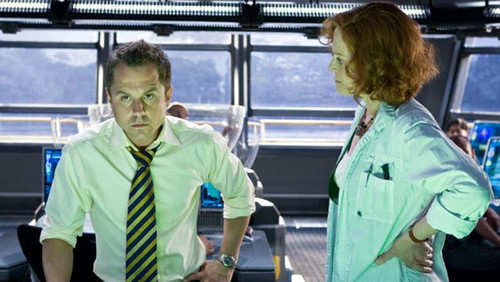
14.00 Jake lacks training. Goes in, to link with his Avatar. Grace going in, too.
16.00 Jake wakes up in Avatar. “Welcome to your new body, Jake!”
(=ENTERS SPECIAL WORLD OF AVATAR)
16.30 Jake walks, doesn’t listen, runs out, has fun. (=INNER JOURNEY CALL)
18.30 Meets Grace’s avatar (“Don’t play with that!”), then goes to sleep.
(=MEETING THE MENTOR)
Sequence B: Refusing Inner Call & Committing to Outer Journey (12mins)
19.00 Wakes up as Jake – “Welcome back”. (=REFUSAL OF THE CALL)
20.00 Introduced to Trudy, she flies the science sorties.
21.00 Col.: Provide intel, get real legs. “Report to me.” Jake: “Hell yes!”
(=CROSSING OUTER JOURNEY THRESHOLD)
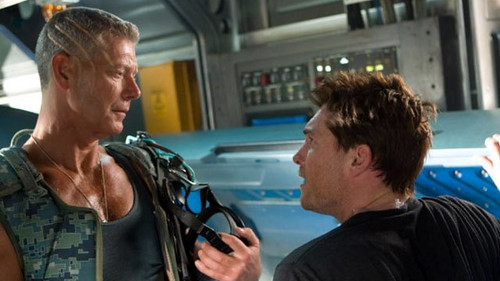
23.30 Grace going in, with heli. Jack loves it. Ship lands.
(=SPECIAL WORLD OF PANDORA)
25.30 Jake explores. Lemurs. Helicoradian flowers. (=TESTS)
27.30 Titanotheres. Jake stands his ground. (=TEST)
29.30 Thanator. Grace: “Run, definitely run!” Jumps off waterfall.
(=SEPARATION, CROSSING THE FIRST THRESHOLD?)
ACT TWO (a)
Sequence C: Meeting Pandora Mentor & Omaticaya (17mins)
31.00 Avatar prepares spear, torch. // Neytiri watches, almost shoots.
32.30 Grace & Trudy looking for Avatar. “He won’t make it till morning.”
33.30 Keeps Viperwolfs at bay, but loses torch. Arrows save him.
35.30 Neytiri is saviour: “Strong heart and no fear; but stupid.”
38.00 She is mad at him, because killing animals is sad. “You’re like a baby.”
41.00 Seeds of Sacred tree land on Avatar; Neytiri stays with him.
41.30 They run. Tsu’Tey etc. appears on horses. They take him to the tribe.
44.00 Parents; mother Moat: “Teach him our ways. See if his insanity can be cured.”
47.00 Sleeping in the leaves of the Hometree.
Sequence D: Two conflicting journeys and a deadline (12mins)
48.30 Jake wakes up. -Is the Avatar safe?
49.00 Parker: Find me a carrot that will get them to move. Three months.
51.00 Jake identifies the Omaticaya from photos; Eywa is their God.
52.00 Avatar with Neytiri, on Direhorse. He connects and rides it.
54.00 Jake reports back.
54.30 To the Hallelujah Mountains to set up the science camp.

57.30 Neytiri and her flying Mountain Banshee. Choose your own when ready.
Sequence E: Avatar gets more deeply infiltrated, initiated (17mins)
60.00 Videolog-montage. Neytiri: ‘moron’. Grace: see forest through her eyes.
64.00 Videolog: Deep connection, network of energy, borrowed.
64.30 Jake shoots deer, says prayer. Neytiri: You’re ready. To banshees.
67.30 Under waterfall. Choose, you have one chance. It will try to kill you.
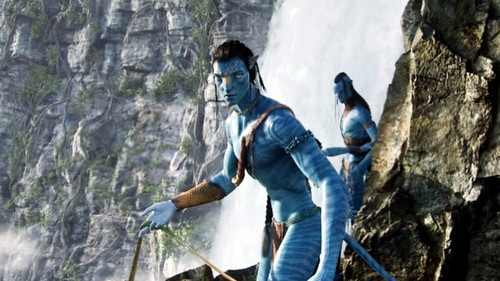
70.00 Fight. Make the bond! Jake falls, then ‘bonds’ & flies.
72.00 Neytiri follows. They fly together.
74.30 Debrief with Grace: The tree of souls. Most sacred place. Lucky swine!
75.30 Attacked by the giant Banshee, the Toruk.
76.30 Neytiri explains: great great grandfather rode the Toruk to unite tribes.
MID SEQUENCE
Sequence F: Jake/Avator reborn – one of the Omaticaya (7mins)
77.30 Everything is backwards now. Out there is true world. In here is the dream.
78.30 Col.doubts resolve. “Terminate mission! Legs back. Done deal. Get it done.”
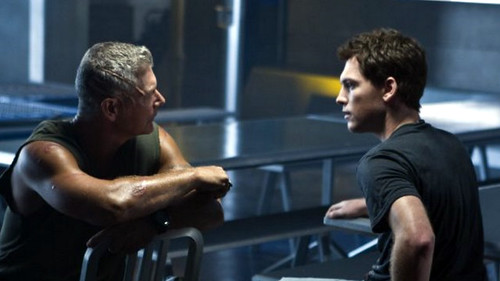
80.30 “Every person is born twice.” Avatar to earn place among the people – forever.
81.30 Initiation ceremony.
83.00 Neytiri & Jake kiss. With you, Jake. Mated for life.
84.00 Videolog. Jake: “What the hell are you doing, Jake?”
ACT TWO (b)
Sequence G: First betrayal, one hour to negotiate retreat (12mins)
84.30 Dozers roll in, Neytiri tries to wake him up//Jake eating //Avatar in danger.
86.00 Jack goes in. // Avatar wakes up; jumps on vehicle & kills video cameras.
87.30 Robo-suits go in. Fight. // Colonel ID’s Jake on photo. “Get me a pilot.”
88.00 Na’vi assemble & prepare for attack.
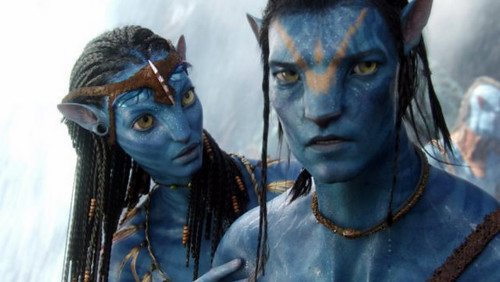
89.00 Neytiri: mated with him. Tsu’tey angry. “He’s not your brother!”
89.30 Avatar: “I am Omaticaya. One of you.”
90.00 Col. goes in to break the link. // Avatar falls. Tsu’tey doesn’t trust him anymore.
90.30 Col. angry. “You let me down.” Grace explains forest biology & pleads.
93.00 Jake’s videolog: “a waste of time. They’ll never leave hometree.”
94.00 Col. & Parker: Minimal casualties. Let’s pull the trigger.
94.30 Trudy: Parker is running the gunships. Jake: Let me try. Parker: One hour.
Sequence H: Diplomacy has failed. All-out war. Ordeal & Death (12mins)
96.00 Avatar pleads with Omaticaya. Neytiri: You’ll never be one. (=APPROACH)
97.30 They’re coming. Military attack on a tree. Na’vi killed.
99.00 Col.: One big tree. Diplomacy has failed. Let’s get this done. Fire!
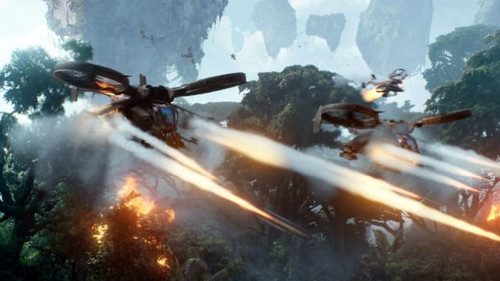
101.3 Moat frees Jake & Grace: Help us! // Trudy defects. (=REWARD)
103.0 The tree comes down. (=ORDEAL)
105.0 Col.: Good work people!
105.3 Neytiri bemoans dying father. (=ORDEAL) To Avatar: “Never come back!”
106.3 Parker: pull the plug. Jake and Grace’s avatars fall. Na’vi flee.
FADE TO BLACK
ACT THREE
Sequence I: Na’vi armies prepare for battle (12mins)
108.0 Trudy frees Jake, Grace & Norm (=REWARD); they run to the ships.
109.3 Col. notified, runs after them, shoots. They fly off. (=THE ROAD BACK)
111.0 Grace is hurt. Hauling up the lab, fly to the Tree of Souls.
112.0 Jake: The people can help you. Grace: Why would they help us?
113.0 Omaticaya assemble at the Tree of Souls.
114.0 Jake VO: “Take it to a whole new level,” He tames Toruk and flies it.
115.0 Omaticaya praying at the Tree of Souls. Avatar arrives on Toruk.
117.3 Avatar calls on Tsu’Tey: I will fly with you. Praying for Grace.
121.0 Grace dies; with Eywa now. Avatar back to Omaticaya. (=ORDEAL)
122.0 Avatar rallying Omaticaya: Send a message! OUR land! (=RESURRECTION)
124.0 Recruiting more tribes.
Sequence J: Military prepare and attack (17mins)
125.0 The Colonel rallying his troops: “Fight terror with terror!”
126.3 Jake is briefed by friends on the plans: 0600 tomorrow.
128.0 Avatar prays to Eywa, who protects the balance of life. (=ORDEAL)
129.3 Next day: Helis attack, carrying explosives.
131.0 Na’vi attack: sky and ground. Casualties on both sides.
134.3 Engage all hostiles! Scorpions: pursue and destroy!
136.0 Trudy intervenes: “You’re not the only one with a gun.”
137.0 On the ground: major casualties. Trudy sacrifices herself and ship.
138.3 Avatar can’t reach Tsu-tey, Norm, Trudy.
138.0 Preparing bomb for dropping.
139.3 Avatar to Neytiri: do NOT attack. An order.
140.0 Hold position… Animals come in to the rescue. Eywa’s heard you. (=REWARD)
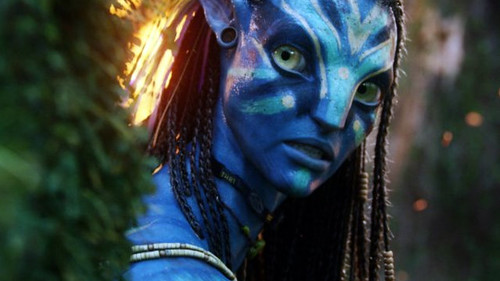
Sequence K: Final Confrontation (15mins)
142.0 30 seconds to payload drop… Avatar intervenes.
143.0 Bombship falls & explodes; battle moves from the sky to the ground.
145.0 Col. moves towards camp, Neytiri attacks, trapped under killed animal.
146.3 Avatar appears, duels with Colonel. (=RESURRECTION)
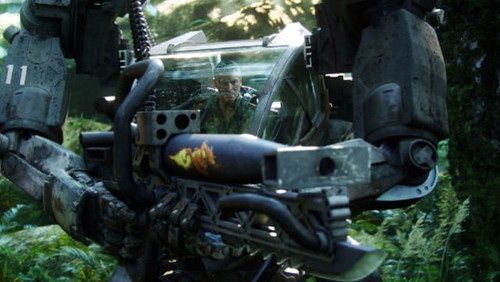
148.0 “Hi Sully… How does it feel to betray your own race? Time to wake up.”
149.0 Jake has trouble breathing. Neytiri kills the Col. with bow & arrows.
151.0 Neytiri finds Jake, gives him oxygen. “I see you.”
Sequence L: Aftermath & New Life as a Na’vi
152.0 “The aliens returned to their dying world.”
152.3 Last video log. I don’t want to be late for my own party. Signing off.
154.0 Avatar: Na’vi Ceremony. Reborn as Avatar.
154.3 THE END
______________________________
ACT ONE
The end of Act One is not entirely obvious to me because unlike the Mid Point and Act Two, I don’t believe Cameron used a FADE TO BLACK – or else I’ve missed it.
Here’s my reasoning for putting the first act break where I did in the breakdown.
Jake’s longing is to get new legs. When the Col. says “I look after my own” and he promises Jake new legs in return for intel, this is a CALL TO ADVENTURE for Jake. There is no REFUSAL and he immediately accepts/CROSSES THE THRESHOLD by promising the Colonel he will report back to him (“Hell yes!”).
More important in this story from a structural perspective will be Jake’s INNER JOURNEY of realisation that he belongs in the world of the Na’vi, where he has REAL legs already. The INNER CALL TO ADVENTURE is the sensation of how much he loves his new body and the fact that he can walk and run. However, he REFUSES THE CALL by going back to the base and returning to the military program.
The SEPARATION from Jake’s ORDINARY WORLD happens in a number of stages. You can say that the arrival on Pandora is a first separation, from planet Earth. The first science sortie as an Avatar is the second and the physical separation from his team when he escapes the wild animal is the final one. Symbolic action for this Separation is the jump off the waterfull, a typical ‘Point of No Return’.
Early in the first sequence, we see Jake’s longing and his flaw: he wants his legs back. But he can’t do anything about it as he doesn’t make enough money. His wheelchair is also perceived as his flaw, as becomes clear when one of the military makes the comment “That is just … wrong.” He doesn’t belong in this military world.
Unlike the usual Hero’s Journey, in which we leave the ORDINARY WORLD at the end of Act One, the CALL TO ADVENTURE introduces Jake to a SPECIAL WORLD – that of his Avatar. This structure is similar to movies such as BACK TO THE FUTURE.
Jake meets with Grace, his ORDINARY WORLD MENTOR. However it is not until he meets her in the SPECIAL WORLD that she assumes her role of giving him ‘advice’ (“Don’t play with that!”) and guide him. Later, he will meet his SPECIAL WORLD MENTOR in the shape of Neytiri.
ACT TWO
In the SPECIAL WORLD of Pandora’s jungle, Jake is immediately confronted with a number of tests. The first is the Titanotheres, the second a Thanator. In both cases, he follows the advice from Grace. Once separated, he will need to develop new skills to withstand the Viperwolfs and here he needs the help from his new SPECIAL WORLD MENTOR, Neytiri.
Act IIa is essentially a succession of tests in a positive, optimistic atmosphere, leading to the Mid Sequence that reverses it all. By completing the ceremony and becoming one of the Omaticaya and mating with Neytiri, Jake’s Avatar has now committed to the Na’vi and betrayed the humans.
Immediately after the Mid Sequence, the Avatar proves his allegiance to the Na’vi by attempting to stop the bulldozers on their way to Hometree. Back at the base, Jake is given a last chance and a deadline (one hour) to negotiate and make the Omaticaya retreat.
But the negotiations fail and the military attack and bring down Hometree, at the cost of many casualties.
This lowest point in the story is the ORDEAL (Crisis) for both Jake and his Avatar. They are arrested; the Avatar by the Omaticaya and Jake by the military. Next they are freed, each by their respective ally: Moat and Judy. This release (REWARD) completes the ORDEAL stage and allows the Hero to set out on the ROAD BACK.
ACT THREE
The last act is not a straightforward battle-confrontation-resolution-aftermath, because the story is explicitly told on two levels.
While the armies prepare for the final confrontation, we see Jake’s Avatar praying to Eywa in what seems a redemptive, spiritual ORDEAL that seals his transformation in the INNER JOURNEY. The REWARD for this follows when later Neytiri says “Eywa has heard you”.
In the OUTER JOURNEY, the story climaxes in the duel with the Colonel and is resolved with the death of the Colonel and the survival of Jake.
The INNER JOURNEY climax lies in the movie’s last sequence, when we see Jake’s last video log about his choice to leave the base forever.
The very last shot before the credits seals this choice, when the Avatar opens his eyes and we know that Jake will continue his life as a Na’vi.
Your comments, please!
______________________________
Could AVATAR have been a more satisfying story in any way? Probably (thanks MM).
Would it have been equally successful? Who knows…
OVERVIEW
ACT I, 3 Sequences (31mins)
ACT IIa, 3 Sequences (46mins)
MID SEQUENCE (7mins)
ACT IIb, 2 Sequences (24mins)
ACT III 3 Sequences (46mins)
Compare this structure with James Cameron’s scriptment of AVATAR.
Total: 12 Sequences (154mins)
(*)If you can think of any other successful films about the same theme, tell us in the comments.
Karel Segers wrote his first produced screenplay at age 17. Today he is a story analyst with experience in acquisition, development and production. He has trained students worldwide, and worked with half a dozen Academy Award nominees. Karel speaks more European languages than he has fingers on his left hand, which he is still trying to find a use for in his hometown of Sydney, Australia. The languages, not the fingers.
Subscribe to our YouTube Channel!

Good work. I like the idea of the alternate work of the Avatar becoming the real world. That the world he knew becoming the alternate world. Brings in the tensions between the two worlds. This with the character tensions with the inner journey.
Thanks for your comment, Stavros.
It’s a relatively short – and bland – Mid Sequence in which the worlds swap. Bland, because the only real tension exists in the scene with the Colonel, when Jake is reminded of his task and we know he’s no longer on the Colonel’s side.
The fact that something DOES change for Jake in that Mid Sequence is immediately confirmed at the very beginning of Act IIb.
Thanks Karel I enjoyed your analysis and largely agree with it. I believe that this film has changed the face of block buster film making forever – yes I think its that good! The magic for me is that as you say the classic story telling structure has once again worked for audiences to produce what seems to be on track to be the highest grossing film of all time -$1 billion to date.
James Cameron is a genius and I cannot wait to see it all again.
Hallo Karel,
thanks for all your hard work. I especially liked the production stills you used to illustrate the story (where did you get them?).
I was interested to see you didn’t mention catharsis on your exposé. I think that the basic cathetic exchange in the film is this: The audience feels good about the (extremely brilliant and virtuoso) gun-porn if they can feel righteous about saving the planet/tree-people.
In this it does a better job than, say, Zack Snyder’s 300, where the killing is merely historically justified by the subsequent (unseen) victory of Athens over the Persian barbarians. Here we get the Real McCoy of Victory pure, and even the Rebirth (and Marriage? and Coronation?) ceremony at the end reminds one of the Dionesian Cult Ceremonies. The cathectic cycle is complete.
Brilliantly made heroic epos, with great gun porn thrown in to boot.
Best Regards,
Simon Sieverts
PS I wonder if the video game will continue the saga?
Thanks for your comment, Simon.
The stills are from IMDb: http://www.imdb.com/title/tt0499549/mediaindex?page=3
I’m afraid I got carried away slightly in terms of what is reasonable under Fair Use, so I’ve just deleted a few of those images again.
You’re right about the catharsis I think. Personally I am not a fan of the story of “300”.
No doubt the game will sequel and prequel the saga!
Thanks Karel, nice to walk out of the cinema and read this.
I wonder, when they talked about Jake’s marine background, rather than building empathy between him and the colonel they could have shown Jake’s inescapable marine conditioning. This may have made Jake’s obedience more believable, and OUR entry into the story could have a sense of escaping corporate anti-environmental conditioning. Of course the classic nemesis model requires them to bond at some stage, I guess.
I kinda wished he’d stopped when the tree fell though.. I’m not sure we deserve to be let off the hook like that.
This is brilliant! Well done.
I am currently in my third year of Univeristy studying film. I have chosen to write my final essay on: ‘Becoming Authentic: The Hero’s Journey in Avatar’ – A question I had created.
Your work proves it applies to the Hero’s Journey, it would be good to quote you within my essay. Is there anything you can add in general to Avatar fitting to the Hero’s Journey?
Thank you
DAISY
thanks, it’s usefull for me…any other simple like this…or any ebook???
Schitterende film, alleen jammer dat deze film, zoals de meeste Amerikaanse films, voor een Amerikaans publiek gemaakt werd. en dat wil zeggen dat het verhaal vooral niet te ingewikkeld mag zijn … Ik heb vaak de indruk naar een stripverhaal met tekst ballonnetjes te kijken … Ik ben onder de indruk van de stap die gezet is, de vooruitgang die op cinematografisch gebied alweer gemaakt is. Dat Peter Jackson en Steven Spielberg tijdens de opnames met hun ogen zijn mogen komen lenen zegt meer dan genoeg ? Maar deze film had ons veel verder kunnen nemen zeker met de middelen/budgetten die voor handen zijn … ik hoop dat RIDLEY SCOTT met zijn prequel van ALIEN, wel verder durft te gaan.
Wel, intussen heb je een antwoord op die laatste vraag…
Persoonlijk vind ik dat Cameron de beste filmschrijver van onze generatie is. “Ingewikkeld” vind ik niet noodzakelijk een kwaliteit. Cameron heeft een complexe, multi-timbrale film gecreeerd die een gigantisch publiek aanspreekt. Daar kan ik alleen maar bewondering voor hebben.
Does breaking the Hero’s Journey into 3 Acts really work?
What Vogler describes as the ORDEAL at the midpoint allows the hero to take the ROAD BACK with the REWARD. However in 3 Act structure (according to Hague) only after the final battle in the Act 3 CLIMAX will there be treasure – i.e realization of NEED and GOAL achieved.
Hague would call this ORDEAL at the midpoint the POINT OF NO RETURN – where the hero is in too deep to back, or as Macbeth says: “I am in blood, steeped in so far, returning were are tedious as go o’er”.
But this isn’t where the hero would have won the treasure yet, or have started the ROAD BACK, which would happen after the FINAL BATTLE in ACT 3.
So does Avatar follow the mythic hero’s journey or 3 Act structure ? Can it be both ?
Yours, confused.
Neither Vogler nor Hauge have a conclusive approach to Act Two. Ironically, if they would listen to each other more carefully, they could resolve what the main problems are.
Vogler gets it wrong when he puts the Ordeal at the mid point. In stead of giving two options, he should acknowledge that most successful films have the Supreme Ordeal towards the end of Act Two.
Hauge should recognise that ‘Point of No Return’ doesn’t mean much. The Mid Point is so much more, in fact I prefer the Mid Point Reversal (I believe Paul Gulino uses this term, too) as the character often changes the approach to effectively the opposite. Here, in stead of fighting the Na’vi, Jake will protect them. In ONE FLEW OVER THE CUCKOO’S NEST, McMurphy first tries to stay IN the asylum but after the MPR he tries to get OUT. In THE LIVES OF OTHERS, the Stasi agent first tries to nail the theater director, after the MPR he protects him. In THE INCREDIBLES, Bob first works FOR Syndrome (he thinks), then fights AGAINST him, etc. etc.
I’ll talk about THE RETURN (THE ROAD BACK) later. In any case, it is very different from the Climax in Act 3.
I like Hague’s PONR – the example he gives – Thelma and Louise – has the robbery, which there is no going back from: they are criminals now. Also, isnt the PONR or MIDPOINT the mirror to the ALL IS LOST moment at the end of ACT 2 – so if the outward goal is to get the girl, the MIDPOINT is to get the girl, but the ACT 2 ALL IS LOST moment is to lose the girl with NO HOPE of ever getting her back – leading to the FINAL BATTLE where the girl is won again! If the CLIMAX is positive – goal won – then the MIDPOINT is also positive. If the CLIMAX is negative the MIDPOINT should be negative – THELMA & LOUISE. Over simplifying maybe! Isn’t the ROAD BACK the RESOLUTION or RETURN with the ELIXIR ?
Plus… isnt the Supreme Ordeal the Final Battle or Act 3 CLIMAX ?
No, the Supreme Ordeal marks the end of Act 2.
The Act 3 Climax is called The Resurrection.
As you know Hague calls the end of Act 2 the MAJOR SETBACK or ALL IS LOST moment. Doesn’t ‘supreme’ mean ‘the highest’ ‘most extreme’ ? Isn’t the Final Battle the toughest, most extreme obstacle in the Hero reaching his goal? Then surely the Supreme Ordeal has to be the Final Battle. Or am I missing something obvious?!
I think it’s just an issue with semantics. I wouldn’t call the end of Act 2 THE ‘supreme’ ordeal because there is an even more supreme ordeal ahead – the Final Battle. I defo prefer major setback.
definition of ‘supreme’:
1. Greatest in power; paramount or dominant.
2. Greatest in importance, degree, significance.3. Ultimate; final:
So the ‘supreme ordeal’ has to be The Final Battle, doesn’t it?
OK I can see why Vogler calls this end of Act 2 All is Lost moment the SUPREME ORDEAL as it’s the supreme ‘negative’ ordeal where all seems lost. As this blog post states:
“The Supreme Ordeal: You’ve walked into the Innermost Cave to confront your worst fears once and for all, and you know there is no turning back; you either make it or break it. This is the final test, the final stage of your initiation. You’ve journeyed into your Innermost Cave to face down the Evil One and suddenly you realized that he, she or it is stronger than you thought. All hope seems lost.”
http://lifecoachesblog.com/2006/03/14/the-heros-journey-part-7-the-supreme-ordeal/
However, in movies that follow Hague’s 3 Act structure I would suggest the entry to the Inmost Cave to fight the Evil One is the Final Battle.
Hague points out that “in Gladiator, at The ‘Major Setback’ or All is Lost moment Maximus refuses to help the leader of the Senate, and Commodus plots to destroy both Maximus and the Senate.
He says “Something must happen to your hero that
makes it seem to the audience that ALL IS LOST. These
disastrous events leave your hero with only one option: he must make one, last, all-or-nothing, do-or-die effort as he enters…
The Final Push
Maximus conspires to escape from Proximo and lead his former troops against Commodus.
Beaten and battered, your hero must now risk everything he has, and give every ounce of strength and courage he possesses, to achieve his ultimate goal. During this stage of your script, the conflict is overwhelming, the pace has
accelerated, and everything works against your hero, until he reaches:
The Climax
Maximus has his FINAL BATTLE with Commodus in the arena.
Several things must occur at the climax of the film: the hero must face the BIGGEST OBSTACLE of the entire story; he must determine his own fate and the outer motivation must be resolved once and for all.”
http://www.storymastery.com/articles/30-screenplay-structure
So, to me, what Hague calls the final push is Vogler’s journey to the Inmost Cave and what Vogler calls the ‘final test to face down the evil one’ is what Hague calls ‘The Final Battle.’
The two structures seem in conflict with each other and it would be fascinating to see how they correlate them in their conferences.
I personally prefer the Hague 3 Act Structure. So does Avatar follow Vogler’s 12 steps or Hague’s 3 Act? Hmmm.
I see what’s happening here, it’s just different terminology.
However, Vogler seems to have the Supreme Ordeal (End of Act 2 Turning Point) actually IN the Inmost Cave whereas Hague saves the Inmost Cave for the Act 3 Climax.
The terminology of Ordeal and Inmost Cave goes back to Joseph Campbell’s HERO WITH A THOUSAND FACES and can’t really be discussed adequately outside that context, which leads to the babylonian confusion.
Hauge’s structural approach is really coarse and overlooks a few essential psychological stages in my view. I much prefer Vogler but would never look at one teacher alone to try and understand the structural mechanics of a good screenplay. That’s why my teaching includes the best of all of these, plus a fair share of my own, in particular the handling of POV and Events vs. Actions.
What are your thoughts on Truby’s 22 steps?
Thanks for clarifying my confusion however!
Glad to have come across this (and glad that it is still up in 2022!). Thanks for your time and for keeping it posted.